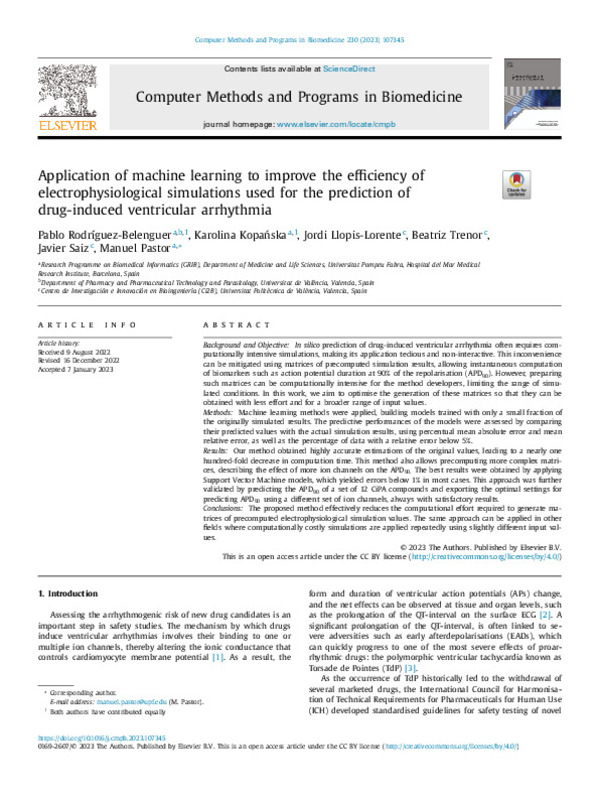JavaScript is disabled for your browser. Some features of this site may not work without it.
Buscar en RiuNet
Listar
Mi cuenta
Estadísticas
Ayuda RiuNet
Admin. UPV
Application of Machine Learning to improve the efficiency of electrophysiological simulations used for the prediction of drug-induced ventricular arrhythmia
Mostrar el registro sencillo del ítem
Ficheros en el ítem
| dc.contributor.author | Rodriguez-Belenguer, Pablo
|
es_ES |
| dc.contributor.author | Kopanska, Karolina
|
es_ES |
| dc.contributor.author | Llopis-Lorente, Jordi
|
es_ES |
| dc.contributor.author | Trenor Gomis, Beatriz Ana
|
es_ES |
| dc.contributor.author | Saiz Rodríguez, Francisco Javier
|
es_ES |
| dc.contributor.author | Pastor, Manuel
|
es_ES |
| dc.date.accessioned | 2023-03-02T19:01:37Z | |
| dc.date.available | 2023-03-02T19:01:37Z | |
| dc.date.issued | 2023-03 | es_ES |
| dc.identifier.issn | 0169-2607 | es_ES |
| dc.identifier.uri | http://hdl.handle.net/10251/192259 | |
| dc.description.abstract | [EN] Background and Objective In silico prediction of drug-induced ventricular arrhythmia often requires computationally intensive simulations, making its application tedious and non-interactive. This inconvenience can be mitigated using matrices of precomputed simulation results, allowing instantaneous computation of biomarkers such as action potential duration at 90% of the repolarisation (APD90). However, preparing such matrices can be computationally intensive for the method developers, limiting the range of simulated conditions. In this work, we aim to optimise the generation of these matrices so that they can be obtained with less effort and for a broader range of input values. Methods Machine learning methods were applied, building models trained with only a small fraction of the originally simulated results. The predictive performances of the models were assessed by comparing their predicted values with the actual simulation results, using percentual mean absolute error and mean relative error, as well as the percentage of data with a relative error below 5%. Results Our method obtained highly accurate estimations of the original values, leading to a nearly one hundred-fold decrease in computation time. This method also allows precomputing more complex matrices, describing the effect of more ion channels on the APD90. The best results were obtained by applying Support Vector Machine models, which yielded errors below 1% in most cases. This approach was further validated by predicting the APD90 of a set of 12 CiPA compounds and exporting the optimal settings for predicting APD90 using a different set of ion channels, always with satisfactory results. Conclusions The proposed method effectively reduces the computational effort required to generate matrices of precomputed electrophysiological simulation values. The same approach can be applied in other fields where computationally costly simulations are applied repeatedly using slightly different input values. | es_ES |
| dc.description.sponsorship | The authors received funding from the eTRANSAFE project, Innovative Medicines Initiative 2 Joint Undertaking under grant agreement No 777365, supported from European Union's Horizon 2020 and the EFPIA. We also received funding from the SimCardioTest supported by European Union¿s Horizon 2020 research and innovation programme under grant agreement No 101016496. J.L.L. is being funded by the Ministerio de Ciencia, Innovacion y Universidades for the Formacion de Profesorado Universitario (Grant Reference: FPU18/01659). The work was also partially support by the Dirección General de Política Científica de la Generalitat Valenciana (PROMETEO/ 2020/043). | es_ES |
| dc.description.uri | https://riunet.upv.es/handle/10251/183067 | |
| dc.language | Inglés | es_ES |
| dc.publisher | Elsevier | es_ES |
| dc.relation.ispartof | Computer Methods and Programs in Biomedicine | es_ES |
| dc.relation.uri | https://riunet.upv.es/handle/10251/183067 | |
| dc.rights | Reconocimiento (by) | es_ES |
| dc.subject.classification | TECNOLOGIA ELECTRONICA | es_ES |
| dc.title | Application of Machine Learning to improve the efficiency of electrophysiological simulations used for the prediction of drug-induced ventricular arrhythmia | es_ES |
| dc.type | Artículo | es_ES |
| dc.identifier.doi | 10.1016/j.cmpb.2023.107345 | es_ES |
| dc.relation.projectID | info:eu-repo/grantAgreement/EC/H2020/101016496/EU | es_ES |
| dc.relation.projectID | info:eu-repo/grantAgreement/ //FPU18%2F01659//AYUDA PREDOCTORAL FPU-LLOPIS LORENTE. PROYECTO: DESARROLLO DE MODELOS MULTI-ESCALA DE CORAZON HUMANO Y HERRAMIENTAS COMPUTACIONALES PARA LA EVALUACION DE LA CARDIOTOXICIDAD DE FARMACOS EN CONDICIONES SANAS Y DE INSUFICIENCIA CARDIACA/ | es_ES |
| dc.relation.projectID | info:eu-repo/grantAgreement/EC/H2020/777365/EU | es_ES |
| dc.relation.projectID | info:eu-repo/grantAgreement/GENERALITAT VALENCIANA//PROMETEO%2F2020%2F043//MODELOS IN-SILICO MULTI-FISICOS Y MULTI-ESCALA DEL CORAZON PARA EL DESARROLLO DE NUEVOS METODOS DE PREVENCION, DIAGNOSTICO Y TRATAMIENTO EN MEDICINA PERSONALIZADA (HEART IN-SILICO MODELS)/ | es_ES |
| dc.rights.accessRights | Abierto | es_ES |
| dc.contributor.affiliation | Universitat Politècnica de València. Escuela Técnica Superior de Ingeniería del Diseño - Escola Tècnica Superior d'Enginyeria del Disseny | es_ES |
| dc.contributor.affiliation | Universitat Politècnica de València. Escuela Técnica Superior de Ingenieros Industriales - Escola Tècnica Superior d'Enginyers Industrials | es_ES |
| dc.description.bibliographicCitation | Rodriguez-Belenguer, P.; Kopanska, K.; Llopis-Lorente, J.; Trenor Gomis, BA.; Saiz Rodríguez, FJ.; Pastor, M. (2023). Application of Machine Learning to improve the efficiency of electrophysiological simulations used for the prediction of drug-induced ventricular arrhythmia. Computer Methods and Programs in Biomedicine. 230:1-10. https://doi.org/10.1016/j.cmpb.2023.107345 | es_ES |
| dc.description.accrualMethod | S | es_ES |
| dc.relation.publisherversion | https://doi.org/10.1016/j.cmpb.2023.107345 | es_ES |
| dc.description.upvformatpinicio | 1 | es_ES |
| dc.description.upvformatpfin | 10 | es_ES |
| dc.type.version | info:eu-repo/semantics/publishedVersion | es_ES |
| dc.description.volume | 230 | es_ES |
| dc.identifier.pmid | 36689808 | es_ES |
| dc.relation.pasarela | S\482368 | es_ES |
| dc.contributor.funder | European Commission | es_ES |
| dc.contributor.funder | GENERALITAT VALENCIANA | es_ES |
| dc.contributor.funder | COMISION DE LAS COMUNIDADES EUROPEA | es_ES |
| dc.contributor.funder | MINISTERIO DE CIENCIA E INNOVACION | es_ES |
| dc.subject.ods | 03.- Garantizar una vida saludable y promover el bienestar para todos y todas en todas las edades | es_ES |








